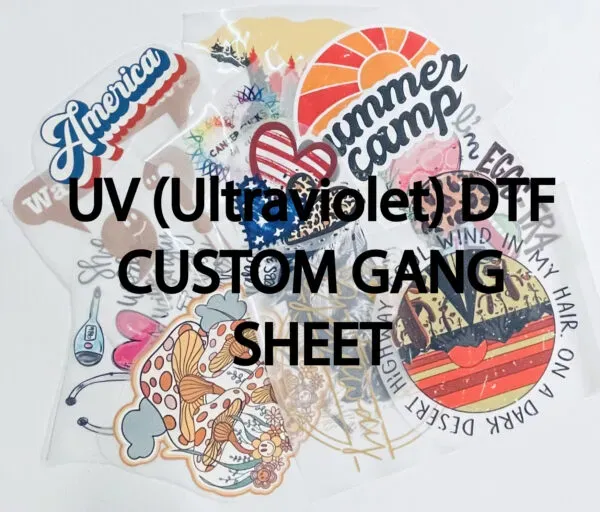UV DTF Gangheet is rapidly emerging as a game-changer in the textile printing industry, paving the way for more innovative fabric decoration methods. This cutting-edge technology marries the efficiency of UV printing technology with the versatility of Direct to Film (DTF) solutions, setting new standards for print quality and durability. With the increasing demand for sustainable textile printing practices, UV DTF gangheet not only delivers vibrant colors but also minimizes environmental impact, positioning it as a frontrunner in eco-conscious fabric printing. As brands and manufacturers seek to stay ahead in the competitive market, understanding the advantages of UV DTF gangheet is paramount for those looking to embrace the future of printing. By ensuring remarkable color retention and adaptability across various materials, this pioneering technology is poised to redefine how textiles are printed in the years to come.
Often referred to as ultra-violet direct-to-film printing, UV DTF gangheet represents a significant advancement in the realm of textile decoration. It leverages the principles of ultraviolet curing technology combined with innovative film transfer methods to produce high-quality prints. This approach not only enhances the visual appeal of fabrics but also caters to the growing market demand for customizable and sustainable textile solutions. Moreover, the inherent versatility of this printing method allows it to work seamlessly on an array of materials, ensuring that businesses can meet diverse consumer tastes. As the textile industry evolves, understanding these emerging technologies, like UV DTF, is essential for anyone looking to explore the expansive possibilities in fabric printing.
The Mechanics of UV DTF Gangheet Printing
UV DTF Gangheet technology stands at the intersection of sophistication and practicality in the realm of textile printing. This innovative process utilizes ultraviolet light to cure the inks on a transfer film, which is then smoothly applied to various fabrics. This method not only improves the vibrancy of colors but also solidifies the inks, resulting in prints that are less susceptible to fading and wear over time. With the ability to produce intricate designs, this method can cater to high-demand industries such as fashion, sportswear, and promotional merchandise.
The remarkable feature of UV DTF Gangheet lies in its capacity to adapt to diverse substrate materials. It can print efficiently on both soft fabrics like cotton and rigid surfaces such as synthetics. This versatility allows manufacturers to expand their offerings, providing customization options that attract a wider consumer base. As printing technology evolves, understanding the mechanics behind UV DTF Gangheet is crucial for any business aiming to stay competitive in the textile sector.
Frequently Asked Questions
What is UV DTF Gangheet and how does it work in textile printing?
UV DTF Gangheet refers to the combination of Ultraviolet Direct to Film printing technology with gangheet, allowing for the mass production of high-quality textile prints. The process involves printing with UV inks that are cured using ultraviolet light, solidifying the ink on a transfer film before being applied to various fabrics. This technology delivers vibrant colors and durable prints, making it a versatile option for textile manufacturers.
Why is UV DTF Gangheet considered an eco-friendly option for textile printing?
UV DTF Gangheet is regarded as eco-friendly because it uses UV inks that emit fewer volatile organic compounds (VOCs) compared to traditional solvent-based inks. This reduction in harmful emissions aligns with the industry’s move towards sustainable textile printing, making UV DTF an environmentally responsible choice for manufacturers looking to minimize their carbon footprint.
What types of fabrics can be printed on using UV DTF Gangheet technology?
The versatility of UV DTF Gangheet technology allows it to print on a wide array of fabrics, including polyester, cotton blends, and synthetic materials. This capability enables manufacturers to expand their product lines, catering to diverse market demands in the fashion and apparel industries.
What are the key benefits of choosing UV DTF Gangheet for textile printing?
Choosing UV DTF Gangheet provides several key benefits including high-quality print resolution with sharp images and vivid colors, increased durability of prints, the ability to print on various substrates, and a more eco-friendly process. Additionally, it promotes cost efficiency by reducing material waste and shortening production times.
How is UV DTF Gangheet contributing to the future of printing in the textile industry?
UV DTF Gangheet is shaping the future of printing in the textile industry by meeting the rising demand for customization and sustainable practices. As the global textile printing market grows, innovations like UV DTF are leading the way, projected to reach significant market valuations by 2028, driven by consumer preferences for innovative and personalized products.
Can UV DTF Gangheet technology be used for on-demand textile printing?
Yes, UV DTF Gangheet technology is well-suited for on-demand textile printing due to its efficiency and cost-effectiveness. It minimizes material waste while allowing manufacturers to produce smaller, customized runs quickly, addressing the increasing consumer demand for personalized textile goods.
| Key Points | Details |
|---|---|
| UV DTF Gangheet Technology | Combines UV printing and Direct to Film transfer methods for vibrant, durable prints on textiles. |
| Advantages | 1. High-Quality Prints: Offers sharper images and vivid colors. 2. Versatility: Works on various fabrics including polyester and synthetic materials. 3. Environmental Sustainability: Emits fewer VOCs, aligning with eco-friendly practices. 4. Market Growth: Estimated market valuation of USD 10 billion by 2028. 5. Cost Efficiency: Reduces material waste and production times. |
| Conclusion | UV DTF gangheet technology is transforming textile printing with its high quality, versatility, and eco-friendliness. |
Summary
UV DTF Gangheet represents a significant leap in the textile printing world, offering an innovative solution that satisfies modern demands for quality and sustainability. This technology not only produces remarkable prints but also promises a broader range of fabric applications, setting a new paradigm in the industry. As businesses increasingly prioritize environmentally responsible options, adopting UV DTF gangheet becomes essential for competitive advantage. With growing market trends indicating a strong demand for customization and efficiency, embracing this cutting-edge technology is not just strategic but necessary for future-proofing textile printing operations.




